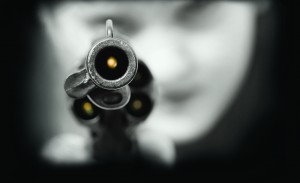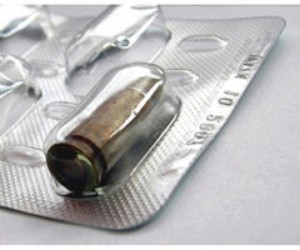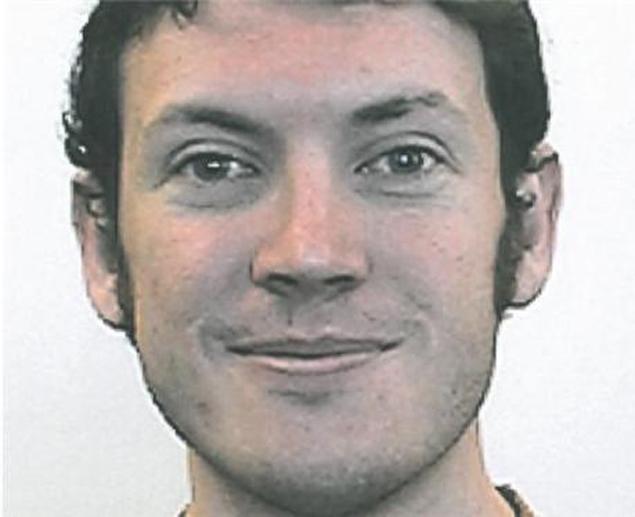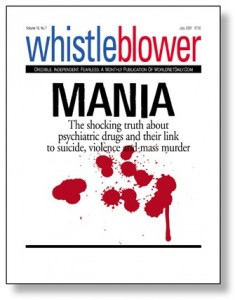Another School Shooting, Another Psychiatric Drug? Federal Investigation Long Overdue
Fact: Despite 22 international drug
regulatory warnings on psychiatric drugs citing effects of mania,
hostility, violence and even homicidal ideation, and dozens of high
profile shootings/killings tied to psychiatric drug use, there has yet
to be a federal investigation on the link between psychiatric drugs and
acts of senseless violence.
Fact: At least fourteen recent
school shootings were committed by those taking or withdrawing from
psychiatric drugs resulting in 109 wounded and 58 killed (in other
school shootings, information about their drug use was never made
public—neither confirming or refuting if they were under the influence
of prescribed drugs.)
Fact: Between 2004 and 2011, there have been
over 11,000 reports to the U.S. FDA’s MedWatch system of psychiatric
drug side effects related to violence. These include 300 cases of
homicide, nearly 3,000 cases of mania and over 7,000 cases of
aggression. Note: By the FDA’s own admission, only
1-10% of side effects are ever reported to the FDA, so the actual number
of side effects occurring are most certainly higher.
Of the 14 shooters documented to be under the influence
of psychiatric drugs, seven were seeing either a psychiatrist or
psychologist. See the list of school shooters on psychiatric drugs here:
School shooters aren’t the only cases commonly found to
be under the influence of psychiatric drugs, here is a list of 10 more
recent murders and murder-suicides, committed by individuals taking or withdrawing from psychiatric drugs resulting in an additional 47 dead and 21 wounded.
( Click the following to view all documented drug regulatory warnings studies on Antidepressants Antipsychotics, Anti-Anxiety and ADHD drugs)
A
bill introduced in New York in 2000 proposed police investigate
psychiatric drug in all cases of violent crimes and suicides. This is a
bill that must be reintroduced and passed on state and federal levels.
Click image to read the bill

Despite
22 international drug regulatory warnings on psychiatric drugs citing
effects of mania, hostility, violence and even homicidal ideation, and
dozens of high profile shootings/killings tied to psychiatric drug use,
there has yet to be a federal investigation on the link between
psychiatric drugs and acts of senseless violence.
The New York State Senate recognized this as far back as 2000, introducing a bill which would “require police to report to the Division of Criminal Justice Services (DCJS), certain crimes and suicides committed by persons using psychotropic drugs,” citing “a large body of scientific research establishing a connection between violence and suicide and the use of psychotropic drugs.”
Unfortunately that bill stalled out in the finance committee. By reviewing the international drug regulatory warnings, studies, and adverse reaction reports submitted to the US FDA below, it is evident that the reintroduction of the New York bill is needed on a federal level in order to determine just how many crimes and acts of violence are being committed by individuals under the influence of drugs documented to induce violence, mania, psychosis, aggression, hostility and homicide.
As the world’s leading mental health watchdog, CCHR has for decades investigated hundreds of acts of senseless violence, working alongside investigative reporters, law enforcement, as well as legislative hearings, such as those held in Colorado following the 1999 Columbine massacre (ringleader Eric Harris was found to be under the influence of the antidepressant Luvox, Dylan Klebold’s autopsy reports were never unsealed).
And while there is never one simple explanation for what drives a human being to commit such unspeakable acts, all too often one common denominator has surfaced in hundreds of cases—prescribed psychiatric drugs which are documented to cause mania, psychosis, violence, suicide and in some cases, homicidal ideation. It is an injustice that the general public are not being informed about the well documented links between psychiatric drugs and violence, and so once again we present the facts:
There have been 22 international drug regulatory warnings issued on psychiatric drugs causing violence, mania, hostility, aggression, psychosis, and other violent type reactions. These warnings have been issued in the United States, European Union, Japan, United Kingdom, Australia and Canada.

Colorado
shooter James Holmes was under the care of a psychiatrist prior to the
shootings, yet no information has been released on whether Holmes, like
Colorado shooter Eric Harris, and countless others, was under the
influence of psychiatric drugs documented to cause violence, psychosis,
and even homicidal ideation.

Click image to read MANIA—The shocking link between psychiatric drugs, suicide, violence and mass murder
In determining what would prompt a person to commit such brutal and senseless crimes, the press must ask the right questions, including: What, if any, prescribed psychotropic drugs the perpetrator may have been on (or in withdrawal from).
Read the international drug regulatory warnings issued on psychiatric drugs causing violence, mania, hostility, aggression, psychosis, and other violent type reactions.
See the recent study from PLoS One here on psychiatric drugs being linked to violence.
Watch this short interview with Michael Moore, author, director and producer of Bowling for Columbine, where he calls for a federal investigation into the link between prescribed drugs and mass shootings such as the 1999 Columbine massacre.
At least fourteen recent school shootings were
committed by those taking or withdrawing from psychiatric drugs. It is
important to note the following lists cases where the information about
the shooters psychiatric drug use was made public. To give an example,
although it is known that James Holmes, suspected perpetrator of the
Aurora, Colorado movie theater shooting, was seeing psychiatrist Lynne
Fenton, there has been no mention of what psychiatric drugs he may have
been taking—though it is highly probably he was taking psychiatric drugs
considering he was under a psychiatrist’s “care”. Also note that all
these mass shootings didn’t just occur in the United States.
Of these 14, seven were seeing either a psychiatrist (5
of them) or psychologist (2 of them). It is not known whether or not
the other half were seeing a psychiatrist, as it has not been published.
1. Huntsville, Alabama – February 5, 2010: 15-year-old Hammad Memon
shot and killed another Discover Middle School student Todd Brown.
Memon had a history for being treated for ADHD and depression. He was
taking the antidepressant Zoloft and “other drugs for the conditions.”
He had been seeing a psychiatrist and psychologist.2. Kauhajoki, Finland – September 23, 2008: 22-year-old culinary student Matti Saari shot and killed 9 students and a teacher, and wounded another student, before killing himself. Saari was taking an SSRI and a benzodiazapine. He was also seeing a psychologist.
3. Dekalb, Illinois – February 14, 2008: 27-year-old Steven Kazmierczak shot and killed five people and wounded 21 others before killing himself in a Northern Illinois University auditorium. According to his girlfriend, he had recently been taking Prozac, Xanax and Ambien. Toxicology results showed that he still had trace amount of Xanax in his system. He had been seeing a psychiatrist.
4. Jokela, Finland – November 7, 2007: 18-year-old Finnish gunman Pekka-Eric Auvinen had been taking antidepressants before he killed eight people and wounded a dozen more at Jokela High School in southern Finland, then committed suicide.
5. Cleveland, Ohio – October 10, 2007: 14-year-old Asa Coon stormed through his school with a gun in each hand, shooting and wounding four before taking his own life. Court records show Coon had been placed on the antidepressant Trazodone.
6. Red Lake, Minnesota – March 2005: 16-year-old Jeff Weise, on Prozac, shot and killed his grandparents, then went to his school on the Red Lake Indian Reservation where he shot dead 7 students and a teacher, and wounded 7 before killing himself.
7. Greenbush, New York – February 2004: 16-year-old Jon Romano strolled into his high school in east Greenbush and opened fire with a shotgun. Special education teacher Michael Bennett was hit in the leg. Romano had been taking “medication for depression”. He had previously seen a psychiatrist.
8. Wahluke, Washington – April 10, 2001: Sixteen-year-old Cory Baadsgaard took a rifle to his high school and held 23 classmates and a teacher hostage. He had been taking the antidepressant Effexor.
9. El Cajon, California – March 22, 2001: 18-year-old Jason Hoffman, on the antidepressants Celexa and Effexor, opened fire on his classmates, wounding three students and two teachers at Granite Hills High School. He had been seeing a psychiatrist before the shooting.
10. Williamsport, Pennsylvania – March 7, 2001: 14-year-old Elizabeth Bush was taking the antidepressant Prozac when she shot at fellow students, wounding one.
11. Conyers, Georgia – May 20, 1999: 15-year-old T.J. Solomon was being treated with the stimulant Ritalin when he opened fire on and wounded six of his classmates.
12. Columbine, Colorado – April 20, 1999: 18-year-old Eric Harris and his accomplice, Dylan Klebold, killed 12 students and a teacher and wounded 26 others before killing themselves. Harris was on the antidepressant Luvox. Klebold’s medical records remain sealed. Both shooters had been in anger-management classes and had undergone counseling. Harris had been seeing a psychiatrist before the shooting.
13. Notus, Idaho – April 16, 1999: 15-year-old Shawn Cooper fired two shotgun rounds in his school, narrowly missing students. He was taking a prescribed SSRI antidepressant and Ritalin.
14. Springfield, Oregon – May 21, 1998: 15-year-old Kip Kinkel murdered his parents and then proceeded to school where he opened fire on students in the cafeteria, killing two and wounding 25. Kinkel had been taking the antidepressant Prozac. Kinkel had been attending “anger control classes” and was under the care of a psychologist.
10 additional recent murders and murder-suicides, resulting in 47 dead and 21 wounded:
- Pittsburgh, Pennsylvania – March 8, 2012: 30-year-old John Shick, former patient of University of Pittsburgh Medical Center (UPMC) and former student at nearby Duquesne University, shot and killed one and injured six inside UPMC’s Western Psychiatrist Institute. Nine antidepressants were identified among the drugs police found in Shick’s apartment.
- Seal Beach, California – October 12, 2011: Scott DeKraai, a harbor tugboat worker, entered the hair salon where his ex-wife worked, killing her and seven others and injuring one. At DeKraai’s initial hearing, his attorney indicated to the judge that DeKraai was prescribed the antidepressant Trazodone and the “mood stabilizer” Topamax.
- Lakeland, Florida – May 3, 2009: Toxicology test results showed that 34-year-old Troy Bellar was on Tegretol, a drug prescribed for “bi-polar disorder,” when he shot and killed his wife and two of his three children in their home before killing himself.
- Granberry Crossing, Alabama – April 26, 2009: 53-year-old Fred B. Davis shot and killed a police officer and wounded a sheriff’s deputy who had responded to a call that Davis had threatened a neighbor with a gun. Prescription drug bottles found at the scene showed that Davis was prescribed the antipsychotic drug Geodon.
- Middletown, Maryland – April 17, 2009: Christopher Wood shot and killed his wife, three small children and himself inside their home. Toxicology test results verified that Wood had been taking the antidepressants Cymbalta and Paxil and the anti-anxiety drugs BuSpar and Xanax.
- Concord, California – January 11, 2009: Jason Montes, 33, shot and killed his wife and then himself at home. Montes had earlier begun taking the antidepressant Prozac for depression related to his impending divorce and a recent bankruptcy.
- Little Rock, Arkansas – August 14, 2008: Less than 48 hours after Timothy Johnson shot and killed Arkansas Democratic Party Chairman Bill Gwatney, the Little Rock Police declared they were investigating shooter’s use of the antidepressant Effexor, which was found in Johnson’s house. A Little Rock city police report later stated that Johnson “was on an anti-depressant and that the drug may have played a part in his ‘irrational and violent behavior.’”
- Omaha, Nebraska – December 5, 2007: 19-year-old Robert Hawkins killed eight people and wounded five before committing suicide in an Omaha mall. Autopsy results confirmed he was under the influence of the “anti-anxiety” drug Valium.
- North Meridian, Florida – July 8, 2003: Doug Williams killed five and wounded nine of his fellow Lockheed Martin employees before killing himself. Williams was reported as having been taking two antidepressants, Zoloft and Celexa, for depression after a failed marriage.
- Wakefield, Massachusetts – December 26, 2000: 42-year-old computer technician Michael McDermott had been taking three antidepressants when he hunted down employees in the accounting and human resources offices where he worked, killing seven.

No comments:
Post a Comment